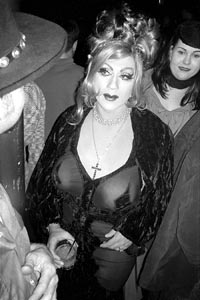 'Expect to be shocked, expect to shock, expect to be entertained, expect to see someone's soul, expect to bare your soul.'
'Expect to be shocked, expect to shock, expect to be entertained, expect to see someone's soul, expect to bare your soul.'
San Francisco's smoldering underground cabarets are twisted talent shows for a city with a bottomless supply of twisted talent
Written by Michelle Goldberg
Photos by Greg Roden
From the outside, the building that houses Junko's, one of San Francisco's underground cabarets looks like just another empty Mission district storefront, with bars and drapes obscuring the windows. Inside, though, the loft-like space (which doubles as a porn studio) is a veritable speakeasy for the '90s, with abundant ashtrays and cocktails served until well after hours. There's a lounge painted entirely in gold and a blizzard of kitsch covering every wall and shelf. A beautiful young crowd lounges in front of a movie screen and a small round stage ringed with Christmas lights.
The night begins with an old movie, Billy Wilder's Some Like It Hot (which, fittingly, itself begins in a speakeasy). Soon after, a pallid woman in a bondage-style bodysuit climbs onstage and performs a straitjacket escape act with a live accordion accompaniment. Later, the musical duo Blue Canary plays old supper-club standards with nothing but a gypsy guitar and a harmonica while one of them, dressed in a top hat, tuxedo jacket, black pants and a leopard-print T-shirt, tap dances and croons his heart out. Finally, toward 3am, Paul Nathan, a drunken magician with John Lennon glasses and a single pirate-style hoop earring, performs astonishing (and lewd) card tricks, ending his act by pulling my six of hearts out of his fly.
That night in the Mission was just one of the many cabarets that have sprung up all over San Francisco. There are cabarets for strippers, rock & roll cabarets, cabarets in dance clubs, and old-fashioned variety shows with sketch comedy, ventriloquists and jugglers. They're twisted talent shows for a city with a bottomless supply of twisted talent. "I want people to get back into the art of appreciating humans," says Tina Keyes, the torch singer who hosts the cabaret at the Werepad. "I don't want people to be satisfied with going someplace and standing in a corner and looking at a disco ball. Expect to be shocked, expect to shock, expect to be entertained, expect to see someone's soul, expect to bare your soul."
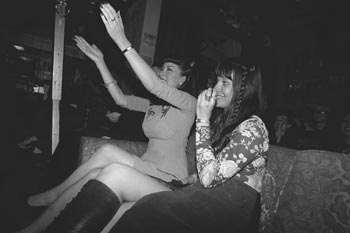
That, at its core, is what cabaret in San Francisco is about--it's about people who are more interested in each other than in, say, big-screen explosions or deafening music, and about performers who'd rather entertain their peers than wharf tourists or big spenders at the Starlight Room. It's a reaction against loud, grungy, alienating rock clubs and against stiff, stodgy theater. The cabaret format has the decadence and the elegance that so many people look for in retro movements, but the acts reflect the '90s, and the variety appeals to contemporary crowds with MTV attention spans.
"Our definition of the cabaret show is some sort of mad twist on a Las Vegas dinner show and Saturday Night Live and Ed Sullivan," says Joe Martin, one of the producers of the Twist Off Cabaret, which has recently started playing the first Thursday of every month at Cafe Du Nord. His partner and the show's MC, Pat Griffin, adds, "Our generation has the paradigm of the TV show. That's our version of cabaret. That's why I think it's so beautiful that we're taking the cabaret format to our peers, because they're very open to it and very receptive to it, much more so than I ever imagined." Indeed, their first show at the Du Nord was standing-room-only.
But while Ed Sullivan may have created their template, Martin still says that television has slashed the audience for live comedy. Besides, there's something incredibly cheesy about comedy clubs. Put comedians under the rubric of a cabaret, though, and crowds will give them a chance. "Right now there are intensely funny, brilliant people who are working for tourist crowds down on Fisherman's Wharf, and they're dying for an opportunity to have a classy outlet and to reach people whose opinions they would appreciate and whose admiration they deserve." Adds Griffin, "The wealth of talent we have in San Francisco needs to be exploited, and that's why we're here. We've been reading our Malcolm McLaren, our Machiavelli and our Svengali."
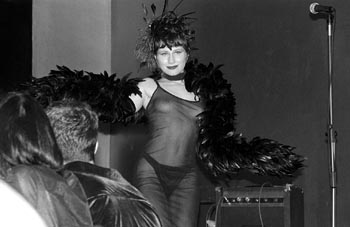
The generation of people who are now in their 20s may be the first in history to have the luxury of being bored with explicit sex. Cabaret involves a different kind of hedonism than we've seen in years, one that's as much about restraint as release. In our bombastic, overstimulated era, cabaret offers something smoldering and intimate.
The pioneer of San Francisco's new cabaret scene is Andrew Ableson, the debonair impresario behind the already legendary Lustre, a Weimar-style cabaret that he ran at the Coco Club. After Lustre ended, he ran Tryst with Tina Keyes at the late cigar bar Fume, and he has recently started a rock & roll cabaret, Symphonies for the Devil, at a plush Polk Street dinner club. On a recent Wednesday, Symphonies for the Devil featured the Mazzy Star-soundalike singer Miranda Richards; Hatcha and Datcha, two girls dressed up in polka-dot blouses and clown makeup who simulated being Siamese twins and then danced with flaming torches to creepy circus music; and a few bands playing polished Britpop confections. (There was supposed to be a stripper, Cherry Jubilee, but she never showed.)
Dressed in a black suit and bright red shirt, Ableson is an impossibly gracious MC with a charming English accent who lavishes praise on his acts. The son of British crooner Frankie Vaughan (England's Tony Bennett, he says), Ableson moved to San Francisco from London three years ago. He had a background as an actor, a musician and a model, so he knew how to put on a show, and he wanted to create "a really saucy cabaret club for people our age--a club that we would want to go to."
Before Lustre, he says, cabaret in San Francisco meant either "the trash end of the drag aesthetic" or a place like Harry Denton's Starlight Room, where tickets were $30 and drinks $7. "That was the challenge--to be able to give people a wonderful theatrical event and not charge them more than 5 or 7 dollars for the whole night," Ableson says.
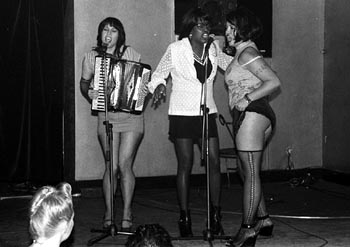
Some Like it Hot: Sophisticated Ladies at a local cabaret.
In the winter of 1996, Keyes' friends brought her to Lustre. "It was the first time that I have ever felt truly at home somewhere," she says. "I saw Andrew Ableson on stage charming the masses, and I fell instantly in love with him. I watched him sing a song, and then I watched a woman named Cherry Jubilee do a beautiful striptease without showing anything, and then I saw a man put his body through a metal-rimmed tennis racket. And I knew that I had landed, that I'd finally found home. It was smoky, it was eccentric, it was everything that I had been searching for for 10 years in San Francisco."
She continues, "I've always been a cabaret performer, but I only found my cabaret a few years ago. I've always been there, being me and going, God, I hope somebody figures it out soon, I hope I find them soon. And they were always there, feeling the same way, lost in this world full of so much sameness. These are people who found the nightclub scene shallow and superficial and offering us nothing, so everyone sort of retreated back into their caves until they found someplace where they felt comfortable and accepted and appreciated, where they could show what they did and be satisfied. It's a very sexy, very sophisticated environment with the most ridiculous things happening in it."
It's odd how much the evolution of the new cabaret in San Francisco resembles that of fin de siècle Paris and, later, Weimar Berlin. "The first propagandists for cabaret wanted the spectator to smoke, drink, comment and join in the chorus as he would at a music hall; they wanted to reclaim the theater for sensuality and mirth," wrote Laurence Senelick, author of two books on European cabaret.
Senelick was writing of the 1890s, but his description is equally true 100 years later. "Cafes, restaurants, wine-cellars, derelict playhouses were converted into platforms for avant-garde drama, song, dance, comedy, prose. The degree of radicalism or sophistication would be determined by local conditions and individual talents, but in most cases the fundamental aim was the same--to provide a refined alternative to the entertainment establishment."
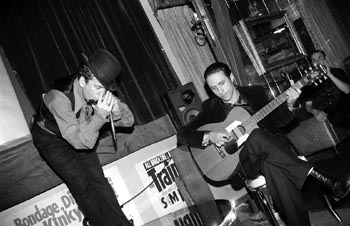
An Elegant Oasis: Blue Canary play soulful standards.
In 1897, a German cabaret producer wrote in his Manifesto for a Cabaret Theater, "Yes, yes: all art and all life, to be reborn, by way of the music hall! ... We'll drag everything into our net: painting, versifying, singing, everything that has beauty and the joy of life in it. What is art nowadays? A minuscule, shimmering spider web in a cranny of life. We will spread it as a golden net over all the people, all life. All those who have hithero avoided the theatre as anxiously as they do the church will come to us."
Senelick says the cabaret formed as a reaction to the bloated Wagnerian grandiosity of culture in the late 1800s, a situation that he says is paralleled today by our mega-blockbuster movies and Disneyfied Broadway musicals. "One of the things people have lost in the theater is intimacy," he says. "When you think of the huge hits on Broadway being sold to a mass public, it's really not that different from movies. With film, no matter what the audience does, it doesn't change. Audience input is irrelevant. The same thing is true of huge musicals--they're just spectacles. There's a need on the audience's part to feel that they are in some way involved."
Senelick also points out that in Berlin in the 1920s, like San Francisco today, drag had already become a common part of bourgeois culture. "There were lots of drag clubs that were on every urban tourist's itinerary," he says. And despite what Ableson said about trashy drag cabaret, nearly everyone in the scene agrees that queens have kept cabaret alive in San Francisco. "Trannyshack is a very beautiful cabaret that's being well supported by its community," says Keyes. "They have a weekly show that they put on within their culture for people to go and experience talent--as well as being a drunken free-for-all that you can black out at."
"Drag queens are now the only people who are really into the cabaret and supporting it," says Jonona Jupiter, a country & western singer and occasional porn actress who recently performed at the Werepad's cabaret. "Within the straight scene, the advent of the rock star killed vaudeville. It was fast fame--no one wanted to work at their craft. There was an anti-art, anti-craft thing going on in the straight scene, whereas the drag queens are still adhering to those old standards."
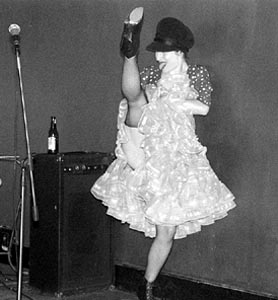
Ableson has drag queens in his shows as well--but he requires that they sing their own songs instead of lip-syncing, because "the minute you start lip-syncing you're one step removed." Local cabaret performers consistently stress that they never want to be ironic about their performances. Jupiter's country-fried act seems quintessentially kitsch until you hear that she's been performing such songs since she was a little girl in Texas. By the time she was 11, she says, she had her own lounge act in a Texas Holiday Inn singing Dolly Parton and Crystal Gayle songs.
As one version of cabaret has been kept alive in drag clubs, another mutant version has survived in our city's abundant strip clubs. Burlesque performers, after all, were once a crucial part of the popular American stage. Now that men can walk into any beckoning North Beach peep show and have a nude woman grind on their lap, the subtle art of the striptease has been largely lost.
Now, though, Krista, a stripper (and Metropolitan contributing writer), has started Ascent, a sexy cabaret where girls can bring their charms to their peers. "Stripping was once more of show, and slowly it's evolved into something that's completely pornographic. Burlesque is more of a chance to celebrate women's beauty. Of course it's still rooted in their bodies, but it's not rooted in their genitals," says Krista.
Like other cabaret performers, Krista says that she'd rather put on a show for her friends than for businessmen and tourists. "It seems healthier," she says. "I still think that young guys have similar sorts of issues around their libidos as older men, but somehow it's more respectful with a younger crowd. It seems like older men are trying to escape more. They seem unhealthy when they come in. I think that younger people are freer to express themselves sexually, so they bring more energy to the cabarets. And women like to have a safe place to explore their own attraction to women, which a cabaret is much more so than a strip club."
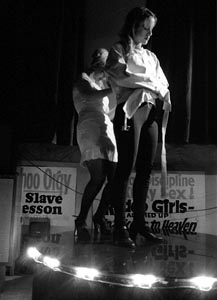 Bondage A Go-Go: A female Houdini at Junko's.
Bondage A Go-Go: A female Houdini at Junko's.
Producers trying to incorporate strippers into their cabarets, though, say they find it hard to balance appreciation and titillation. "I've only seen two people strip artfully in the past few years," says Keyes. "I've only seen two strippers artfully and beautifully tease us with taking their clothes off and not just have the whole experience be about seeing their tits. 'Here, here's my tits.' Well, that's not entertainment to me. But it's hard. Even I was up against it--I'd be like, 'Look at that stripper, she's so tacky,' surrounded by guys who were all like, 'Oh, she ain't so bad,' because they were being stimulated and I was totally bored. They were being stimulated--how do you fight that? You can't."
Says Ableson, "It was a hard ball to juggle initially. Our performers never take their panties off. It was all about the burlesque. We had a lot of strippers work for us, and we whittled them down to the ones who were right. We wanted to work with strippers to pick music to complement what they were doing, and there were little scenarios with a beginning, middle and end. It's all about how you talk about them and how you thank them afterwards, not like they are performing animals and then just carted off."
The generation of people who are now in their 20s may be the first in history to have the luxury of being bored with explicit sex. Cabaret involves a different kind of hedonism than we've seen in years, one that's as much about restraint as release. In our bombastic, overstimulated era, cabaret offers something smoldering and intimate. "People definitely need to come out of these dark holes with excruciatingly loud music and no human contact," Keyes says. "Turn the music down! Let people talk to each other! Jesus Christ, you've got all these beautiful people, let them talk to one another! Cabaret is about people deciding that they'd rather be with one another in a raw form than be in front of their television or in front of a movie screen. We're fed too much already--we want people to bare what's inside of them. That's what's entertaining."
[ San Francisco | MetroActive Central | Archives ]
![[MetroActive Stage]](http://metroactive.com/stage/gifs/stage468.gif)